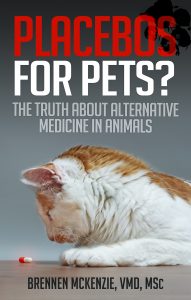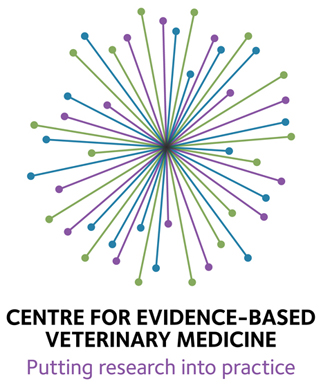When I was training to be a veterinarian, an older vet once described the nature of his work this way, “I make decisions for a living.” After more than 8 years in practice, I know exactly what he meant. The process of taking the information I get from a pet owner and from my physical examination and then using it to set up a diagnostic and treatment plan involves making many, many decisions. Which pieces of information are important and which irrelevant? How reliable are the owner’s observations? What information from the pet’s previous history might shed light on the current problem? What additional information do I need to make a diagnosis? What diagnostic tests are likely to be safe, useful, affordable, and logistically feasible? What is the true diagnosis and what treatment should I recommend? How do I assess the response to treatment, both beneficial and adverse effects? What do I do if the owner declines some or all of my recommendations? What ultimately is in the best interests of the pet and will best promote their health and well-being? And on, and on, and on for multiple patients all day every day.
This is often an intellectually exciting and stimulating process. It is also often frustrating, especially when information I need is unavailable, or when I make the wrong decision, as I inevitably will sometimes being human. One of the greatest challenges, in both a positive and negative sense, is dealing with uncertainty. Lay people often view clinical medicine as a rather mathematical process. The see the doctor as taking historical and physical exam information, and maybe some diagnostic test results, plugging them into an algorithm established by experience, tradition, and scientific research, and coming out with The Answer printed in black and white at the bottom of the paper like an old-fashioned adding machine. When the doctor expresses uncertainty or inserts caveats into his description of the diagnosis or treatment, the client is likely to assume this represents a gap in the clinicians knowledge or competence. The Answer is presumably out there waiting for the right doctor to ask the right question or run the right tests and find it.
While there are particles of truth in this image, it ignores many sources of uncertainty. I’ve already mentioned one which bedevils the veterinarian, which is the often surprising lack of knowledge owners may have about their own pets. Historical information is notoriously unreliable, as are the theories, often supported with internet citations, that owners bring as to the nature of their companion’s problem. Now I realize the owner is most often the single best source of information about the pet, but even the most astute owner may not notice things that only a trained health care provider would notice, and many owners unfortunately can’t even tell me whether their animal is eating or eliminating normally.
Obviously, the information that can be obtained directly from the patient is often limited. Animals can show signs of pain, pruritis, and other physical sensations that might indicate what the problem is, but they cannot give the sort of precise descriptions of their symptoms we might hope for. And despite the claims of innumerable self-professed dog/cat/horse whisperers out there, there are serious dangers to accepting as reliable one’s own intuitive impressions of what an animal is feeling, as I discussed in my post on Animal Hospice care.
Other sources of uncertainty include the fundamental limits of our understanding. Though the progress of the last century in understanding the complex relationships that constitute physiology and the various causes and risk factors associated with disease is absolutely astounding, and continuing at a breakneck pace, the reality is there is much we still do not know. And the volume of what is known is so vast that it is impossible for any one individual to have an adequate command of all the relevant and constantly changing information needed to properly diagnose and treat any condition. Atul Gawande illustrates this limitation in human medicine beautifully in his book Complications, and it is even more of a factor for veterinarians who rarely specialize to the extent MDs do and who treat multiple species.
And while I take a risk venturing into the territory of epistemology, I think it is likely that much of the true, underlying nature of complex phenomena, like organisms and their health or diseases, is probabilistic rather than strictly deterministic. Certainly, in medicine we can often say with great accuracy how a group of patients with a particular condition will do over time based on research, but we are rarely able to say with any certainty how an individual patient with the condition will fare. While this may be due, to a large extent, to the lack of adequate knowledge and measurement capacity, it may also be due to a fundamental unpredictability to complex systems. Chaos theory, quantum mechanics, and the philosophical approaches grouped under the label of indeterminism all address this possibility, and while it is true that these theories may not always be applicable to the problems of everyday life (especially in the case of quantum mechanics, which applies, as far as we can determine, only at the subatomic level), they do suggest that not all natural phenomena are going to be amenable to precise, accurate prediction regardless of how accurate and detailed our information about them is.
Given, then that we must make important decisions with significant consequences on the basis of imperfect information and with the understanding that we will never be as accurate in our assessments and predictions as we would wish, what is the best strategy for making the necessary decisions anyway? First, there is a psychological hurdle we must overcome. I have seen some new veterinarians absolutely paralyzed with indecision when they first encounter the imperfect world of clinical medicine outside of the university. And some eventually give up practicing because it is too difficult to accept the reality that they will make imperfect choices and mistakes despite their best efforts, and that some of these will result in harm to their patients. For most of us, though, we must find the confidence necessary to deal with this reality and to accept that we can only do the best we can and that however imperfect it is better than if we did not even try.
I have seen far more veterinarians, unfortunately, cope with the uncertainties of medical decision making through an excess of confidence in themselves and their choices. Given that we do not have the detailed accounting of outcomes that MDs often have in hospitals, there are rarely formal mechanisms in place for a vet to determine how well they are doing their job, either in an absolute sense or in comparison to their peers. Confirmation bias, cognitive dissonance, and many other normal human cognitive predispositions make it very difficult for us to accurately assess our own performance. Like most people, we will tend to see what we want to see, which is that we are competent, caring, and effectively helpful. And while this is true for most veterinarians, the reality is that we likely overestimate our own abilities and underrate our flaws just like everybody else.
Other vets will deal with uncertainty by slavishly following formulae. Memorizing simple guidelines along the lines of “If THIS, then THAT” and applying them to every case is comforting in that it essentially eliminates decision making all together. Of course, it also eliminates assiduous observation and critical thought, which are essential for the practice of good, sophisticated medicine. One of the common objections to evidence-based medicine is that it is simply a way to enforce this sort of robotic algorithmic approach on everyone. As I’ll discuss, this isn’t really true, but the objection is at least founded on an appropriate disdain for such an approach.
It will come as no shock to those who are familiar with this blog that my answer to dealing with the uncertainties of medical decision making is to apply the paradigm of science-based medicine (SBM — strictly speaking, this is different in subtle but important ways from evidence-based medicine [EBM], but for present purposes they are essentially the same). I view taking on the SBM approach as something a bit like embarking on a 12-step recovery program. Below, I outline and discuss some of the steps involved. (There is, of course, a certain whimsical tone in such a presentation, but the content is an honest representation of the approach I believe veterinary medicine needs).
1. We must begin by admitting we have a problem. This is probably the most important, and certainly the most difficult of the steps. We must acknowledge that our decisions are limited by inevitable uncertainties and that while we can never achieve perfection we can do better with help than we do with a traditional reliance on our own experience, intuition, knowledge, and skills. The greatest resistance I get from other veterinarians to SBM stems from the idea that they don’t need it because they can reliably assess themselves and their diagnostic and treatment approaches just fine. A lot of what this blog is about is pointing out how mistaken this excessive and misplaced confidence is. I acknowledge that it is a natural response to the distress caused by uncertainty, but it is not the right strategy to cope with this distress.
2. Having accepted our limitations, we must be willing to overcome them. This involves educating ourselves about the specific weakness and limitations that diminish the quality of our decision making, It also involves taking concrete steps to address them even though this means letting go of familiar patterns of behavior and strategies that we are comfortable with and trying out new and unfamiliar approaches. We must have an ongoing, never-ending willingness to identify and acknowledge weakness in our knowledge and our practices and the courage to make changes even in long and dearly-held beliefs and behaviors.
3. Accepting that we need to change, we must acknowledge that there is a higher source of knowledge and evaluation than experience or tradition. This is, of course, the scientific method. We will rarely have as high a quality of evidence as we might like given the financial and logistical barriers to clinical and basic veterinary medical research. But we must be committed to accepting the conclusions of the best available evidence as more reliable than those of lower-quality sources of evidence such as our personal experiences. If well-designed and conducted research contradicts my intuition or personal clinical experience, I must be willing to defer to the more reliable source of information.
I do understand how very difficult this is for people in general, and doctors in particular I suspect. But it has been shown time and time again that the beliefs and intuitions of human beings, even multiplied by many people over extended periods of time, are inferior to the conclusions of reliable scientific research. The progress in medicine and the increase in the length and quality of our lives since we began moving away from faith-based and tradition-based medicine and towards science-based medicine is dramatic and incontrovertible.
4. We must then proceed to educate ourselves, our colleagues, and our clients. We must set up systems for generating reliable scientific information and making it easy to access for general practitioners. The Evidence-Based Veterinary Medical Association (EBVMA) is a group dedicated to doing precisely this, and I encourage all veterinarians and pet owners to support their work. Setting up resources such as online journal access, evidence-based reviews along the lines of the Cochrane Reviews, and other such tools would make it easier for practitioners to employ a science-based strategy.
However, they will only turn to this model if we who understand its benefits can make the case to our colleagues that they should, for the sake of their patients and clients. By education and by example, we have to show other veterinarians how the inevitable uncertainties in medical decision making can be minimized by an SBM strategy.
And we must educate our clients so that they can be more effective participants in their pets’ healthcare. Clients who understand the nature of medical decision making will be better able to make sound, informed choices among the options offered to them by their veterinarians. Client values and resources are a key factor determining what we can do for our patients, so we must include them in the decision-making process for practical as well as ethical and philosophical reasons. And the frustration and miscommunication that all too often taints the veterinarian/client relationship will be lessened if our clients understand that medicine is neither a straightforward mathematical process with clear right and wrong answers nor a mystical and vague “art” that depends solely on the talent and wisdom of a particular clinician.
As I mentioned earlier, the objection often made to SBM and EBM approaches is that they seek to impose a cookie-cutter uniformity and robotic system of rigid decision trees on clinicians. This might be true in a deterministic world with the availability of perfect information, but in the real world there will always be uncertainties and gray areas that require a thinking and caring doctor. Contrary to the impression I sometimes give, I believe that clinical experience and intuition are forms off evidence. They are very low-level evidence, and far less reliable that higher-level forms, but they are often all we have to go on, and they can serve us well if carefully and judiciously applied, with great humility. And even when the evidence is strong and we can define the medical parameters of a situation well, medical decisions often depend on non-medical decisions about values and interests. We may be able to say very accurately what the likely treatment outcomes are for a particular disease given the alternative choices, but that doesn’t necessarily tell us what the right thing to do is for a given patient and their family.
And in order for the veterinarian and client to work effectively as a team for the best interests of the pet, the vet must be able to understand and communicate the nature of the medical situation, the options available, and the inherent uncertainties in the decision-making process to the pet owner. All of these are reasons why even in the best case where SBM guides our practice, there is a need for the experience and skills of the veterinarian.
Many of my biggest concerns about CAM and the philosophy that underlies much of it are related to how uncertainty is handled. Many of the inappropriate responses to uncertainty I see mainstream veterinarians take sometimes are proudly adopted as foundational principles in CAM. Often uncertainty is denied entirely, with CAM practitioners claiming all diseases can be definitively traced to a simple causal schema (unbalanced ch’i or humours, innate intelligence blocked by subluxations, toxins, and so on). Denying differences between individuals, species, or diseases and blaming all illness on universal vitalist forces gone awry is the ultimate abdication of responsibility for making careful, informed medical judgments.
Uncertainty in treatment outcomes are often denied as well. Worsening of the patient’s condition is frequently taken by homeopaths to be a sign of improvement, a so-called “healing crisis.” Of course, improvement in symptoms is also taken as a sign of improvement, so there’s no way to lose! As I’ve related before, CAM believers are often unwilling or unable to admit any room for improvement in the wisdom received from millennia or centuries or decades of tradition. While I believe the best response to uncertainty is open acknowledgement of it and an ongoing effort to improve and change, tradition-based practices are founded on the principle of preserving and not questioning received wisdom. And the reliance on anecdote and testimonial commonly seen in CAM venerates the individual experience and intuition. However, I believe less rather than more respect for this form of evidence is the key to more effectively managing the uncertainty in decision making.
Finally, in case I haven’t emphasized it sufficiently, I believe that a degree of uncertainty and unpredictability is intrinsic to medicine and we will never be free of it. Accepting this ourselves as veterinarians or our clients as owners to make perfect decisions is vital to providing good care. Recognizing our limitations not only helps us accept a better methodology, but it frees us from the illusion that we can be perfect or that we can control all outcomes for all of our patients. This makes us not only better doctors but, I suspect, happier people.









